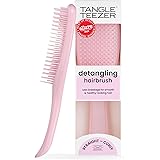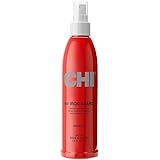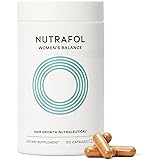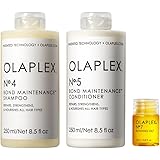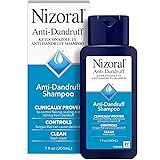What is Hair Porosity?
Hair porosity refers to the hair’s ability to absorb and retain moisture and other substances, ultimately influencing the overall health and appearance of an individual’s hair. At its core, hair porosity is determined by the state of the hair cuticle, the outermost protective layer that surrounds each hair strand. The cuticle consists of overlapping, scale-like cells that can vary in tightness, which impacts how easily moisture can enter or escape the hair shaft.
Understanding hair porosity is essential for effective hair care, as it dictates the best products and methods to use for maintaining hair hydration and overall vitality. There are three main types of porosity: low, medium, and high. Each type presents distinct characteristics regarding moisture absorption and retention. Low porosity hair has tightly bound cuticles, making it challenging for moisture and products to penetrate, thus requiring specific approaches in hydration techniques. Conversely, high porosity hair features gaps and holes in the cuticle, which allows for rapid moisture absorption but also leads to quick evaporation, often resulting in dryness. Medium porosity hair falls somewhere in between, generally requiring a balanced regimen that supports both moisture retention and occasional product treatments.
The significance of hair porosity cannot be understated, as it influences not only the effectiveness of conditioning and styling products but also the overall scalp health and resilience of the strands. Additionally, knowing one’s porosity type empowers individuals to adopt tailored care routines, enhancing their hair’s shine, strength, and texture. By addressing these unique needs, one can foster healthy, manageable hair, thereby showcasing its natural beauty. Understanding hair porosity is, therefore, a crucial first step toward achieving optimal hair health and aesthetic appeal.
Types of Hair Porosity
Hair porosity refers to the hair’s ability to absorb and retain moisture, which is primarily determined by the structure of the hair cuticle. Understanding the different types of hair porosity—low, medium (also known as normal), and high—is essential for establishing a customized hair care routine that caters to one’s specific needs.
Low porosity hair features a tightly bound cuticle layer that lies flat against the hair shaft. This structure makes it challenging for moisture and products to penetrate, often resulting in difficulty absorbing conditioners and oils. Individuals with low porosity hair may notice that products tend to sit on the surface rather than being absorbed. To care for low porosity hair, it is beneficial to use heat during conditioning treatments, which can open the cuticle and facilitate moisture absorption. It is also advisable to opt for lightweight products to avoid buildup.
In contrast, medium porosity hair, characterized by a cuticle that is neither too tightly nor too loosely bound, is generally considered the ideal porosity type. This hair type can easily absorb moisture while also retaining it effectively. Medium porosity hair often requires a versatile regimen that balances moisture and protein treatments. This flexibility provides a solid foundation for maintaining healthy hair. Regular trims and the use of moderate-strength hair products can help sustain the well-being of this porosity type.
Finally, high porosity hair has a cuticle that is either raised or damaged, allowing for quick absorption of moisture but posing challenges in moisture retention. This type of hair often becomes frizzy and dry due to its inability to hold onto hydration. To care for high porosity hair, using heavier creams and oils can lock in moisture, thereby improving its elasticity and overall health. Additionally, incorporating protein treatments periodically can aid in strengthening the hair shaft.
Low Porosity Hair: Characteristics and Care
Low porosity hair is characterized by a tightly bound cuticle layer, which makes it more resistant to moisture absorption. Individuals with this hair type may notice that their strands feel smooth and often look shiny. However, due to the hair’s structure, moisturizing products may sit on the surface rather than being absorbed, making it crucial to identify specific care strategies to maintain optimal hydration.
One of the primary methods to identify low porosity hair involves a simple water test. When a strand of hair is placed in a glass of water, low porosity hair will float for a significant amount of time before it begins to sink. Additionally, visual cues such as a smooth, shiny surface and minimal frizz can indicate low porosity. While it may appear healthy, this hair type often struggles to hold moisture, resulting in dry ends and potential breakage without proper care.
To effectively care for low porosity hair, it is essential to incorporate heat into treatment routines. Applying heat during conditioning treatments can help open the cuticle layer slightly, allowing moisture to penetrate more effectively. Using a warm towel or a hooded dryer while deep conditioning can significantly enhance the absorption of moisture and nutrients. Furthermore, avoiding heavy products is imperative, as they can lead to buildup without providing adequate hydration.
Opting for lightweight, water-based products is recommended since they can better penetrate the strands. Look for ingredients like aloe vera, glycerin, and light oils that won’t weigh the hair down. Incorporating regular clarifying treatments can also help remove any product buildup, ensuring that moisture can better infiltrate the hair cuticle. Overall, understanding low porosity hair enables individuals to tailor their hair care routine for improved moisture retention and overall health.
Medium Porosity Hair: Characteristics and Care
Medium porosity hair is characterized by its balanced structure, which allows for an optimal absorption and retention of moisture. This hair type has cuticles that sit somewhat loosely, enabling it to easily take in hydration from various hair care products while also preventing excessive loss of moisture. As a result, individuals with medium porosity hair often experience less frizz, improved elasticity, and enhanced overall health compared to those with low or high porosity hair.
Another notable feature of medium porosity hair is its versatility when it comes to product use. This hair type can thrive with a wide array of products, from lightweight leave-in conditioners to richer creams and oils. The ability to experiment with different formulations makes maintaining and styling medium porosity hair relatively straightforward. These products can help enhance shine, improve texture, and provide necessary hydration without overwhelming the hair shaft.
To care for medium porosity hair effectively, it is recommended to incorporate regular moisture treatments into one’s hair care routine. Utilizing deep conditioning masks or moisturizing hair treatments once a week can provide the hydration that medium porosity hair needs to remain healthy and strong. However, it is crucial to avoid excessive manipulation, as medium porosity hair can become easily weighed down or damaged if subjected to frequent heat styling or harsh chemicals.
Additionally, implementing a balanced regimen that includes shampooing, conditioning, and occasional clarifying can further promote the health of medium porosity hair. Using sulfate-free shampoos and rich conditioners will ensure that moisture is retained while allowing the hair to maintain its natural shine and bounce. In conclusion, caring for medium porosity hair requires a gentle, balanced approach that caters to its unique needs while ensuring that it remains nourished and healthy.
High Porosity Hair: Characteristics and Care
High porosity hair is characterized by its unique structure, which consists of very open cuticles that allow moisture to enter easily, but also makes it difficult to retain that moisture for extended periods. As a result, this hair type often appears frizzy, dry, and prone to breakage. The susceptibility to damage is heightened due to the inability to hold onto crucial moisture, leading to a constant cycle of dryness and brittleness. Identifying high porosity hair can be accomplished through a simple water test; if a strand quickly sinks in water, it is likely of high porosity.
Individuals with high porosity hair may notice that their strands absorb products rapidly but fail to maintain moisture levels. This can be exacerbated by environmental factors, such as humidity, and by the use of heat styling tools, which can further lift the hair cuticles. Therefore, care methods and products specifically designed for high porosity hair become essential to support its health and vitality.
When it comes to hair care, heavier creams and oils are highly recommended for high porosity hair. These products create a barrier to help lock in moisture. Look for ingredients such as shea butter, castor oil, and avocado oil, which can provide both nourishment and hydration. Additionally, consider employing moisture retention techniques, such as the LOC (Liquid, Oil, Cream) method, that focus on layering products to secure hydration. Deep conditioning treatments are also beneficial, allowing for adequate saturation of moisture and promoting smoothness in texture.
Ultimately, recognizing the characteristics of high porosity hair is the first step in providing appropriate care. By utilizing targeted products and techniques, individuals can mitigate the effects of high porosity and maintain healthier, more resilient hair.
How to Determine Your Hair Porosity
Understanding your hair porosity is essential for effective hair care. Hair porosity refers to the hair’s ability to absorb and retain moisture. Knowing your porosity type can help you choose the right products and techniques to maintain healthy hair. There are several methods to determine your hair porosity, notably the water test and observing your hair’s reactions to various conditions.
To conduct a simple at-home porosity test, start by gathering a clean glass of water and a few strands of your hair. It is important to use hair strands that have not been treated with any products, as residues can affect the results. Once you have the hair strands ready, place them gently in the glass of water. Observe how your hair behaves in the water over a period of 2-4 minutes.
If your hair floats on the surface of the water, it has low porosity, meaning it resists moisture absorption and often takes longer to get wet. Conversely, if the hair sinks quickly to the bottom, it indicates high porosity, suggesting that your hair absorbs moisture readily but may also lose it just as fast. If your hair hovers in the middle of the glass, it has medium or normal porosity, indicating a balanced ability to absorb and retain moisture.
In addition to the water test, monitoring how your hair reacts to products can also offer valuable insights. For instance, pay attention to how quickly your hair absorbs leave-in conditioners or how it reacts to styling products. Over time, this mindfulness can help you identify your porosity type, leading to more effective hair care routines tailored to your specific needs. Recognizing your hair porosity is a crucial step in customizing your hair care strategy to achieve optimal health and appearance.
Common Mistakes in Hair Care Based on Porosity
Caring for hair can be a complex endeavor, particularly when considering the concept of hair porosity. Many individuals make missteps in their hair care routines that stem from a misunderstanding of porosity levels, which can lead to detrimental effects on hair health. One prevalent mistake is the incorrect application of hair products. For instance, those with high porosity often believe that slathering on heavier products will provide sufficient moisture. However, it’s essential to understand that high porosity hair tends to absorb moisture quickly but also loses it just as fast. Applying too many heavy products without sealing them properly can lead to build-up and ultimately weigh the hair down.
Another common error involves the neglect of tailored routines. Individuals with low porosity hair frequently assume that heat will open their cuticles for better product absorption. While warmth can aid penetration to some extent, excessive heat can damage hair textures instead of fostering health. Consequently, those with low porosity hair should focus on using lighter products and applying them on slightly damp hair to enhance absorption without the risks posed by heat.
Furthermore, many individuals wrongly assume that all products are equally effective regardless of their hair’s porosity. This assumption can lead to disappointment and exacerbated hair concerns. For example, protein treatments might benefit individuals with medium to high porosity, whereas those with low porosity often find that excessive protein can lead to brittleness. Understanding and recognizing your specific hair porosity is vital in selecting suitable products that will enhance hair health without compromising it. Therefore, it is crucial to educate oneself about hair porosity to avoid these common pitfalls and foster healthier hair care practices.
Building a Hair Care Routine by Porosity
Understanding your hair’s porosity is essential for creating an effective hair care routine. Hair porosity refers to how well hair can absorb and retain moisture, and it is categorized into three types: low, medium, and high porosity. Each type requires distinct care strategies to maintain healthy hair and prevent damage.
For low porosity hair, which tends to resist moisture absorption, a routine involving lightweight, water-based products is advisable. Choose shampoos that contain mild surfactants and avoid protein-rich formulations, as these can lead to buildup. When conditioning, use heat to open the cuticles; a warm towel or a hooded dryer can help. Aim to wash your hair every 7 to 10 days to avoid stripping it of essential oils.
Medium porosity hair is often considered the easiest to manage. It usually requires a balanced combination of protein and moisture. Incorporate moisturizing shampoos and deep conditioners into your routine, using them every 5 to 7 days. Regular trimming will also be beneficial for this hair type by eliminating split ends while maintaining the hair’s overall health. Avoid excessive heat styling, and when you do, always use a heat protectant.
High porosity hair, on the other hand, absorbs moisture quickly but also loses it just as fast, making it susceptible to dryness and damage. For this type, opt for rich, moisturizing products that help seal in moisture. Use a leave-in conditioner and oil to lock in hydration, applying them after every wash, which should occur every 3 to 5 days. Incorporating protein treatments occasionally can strengthen high porosity hair and help fill in gaps in the hair’s cuticles.
Regardless of your porosity type, maintaining a balanced hair care routine is crucial. Regular assessment of your hair’s condition will allow you to adjust products and routines as necessary. Over time, you will find the right combination that supports your hair’s health and appearance.
Conclusion and Final Thoughts
Understanding hair porosity is crucial for anyone looking to enhance their hair care routines effectively. Hair porosity refers to the hair’s ability to absorb and retain moisture, which is a critical factor in determining the best products and techniques suited for individual hair types. There are three primary types of hair porosity: low, medium, and high. Each type has distinct characteristics and requires tailored care to maintain healthy and beautiful hair.
For individuals with low porosity hair, utilizing lightweight products that don’t overwhelm the hair shaft is essential. On the other hand, medium porosity hair often has the flexibility to use a mix of formulations, allowing for versatility in care. High porosity hair tends to absorb moisture rapidly but loses it just as quickly; therefore, using products that help seal in moisture is vital. By recognizing the specific needs of their hair porosity, individuals can select appropriate cleansers, conditioners, and treatments that suit their strands.
Assessing personal hair porosity is a straightforward yet beneficial process that empowers individuals to make informed choices regarding their hair care practices. This knowledge not only encourages healthier hair but also promotes greater confidence in one’s hair management routine. As such, understanding hair porosity should be regarded as an important foundation for any hairstyling regimen, impacting everything from daily washing to special treatment applications.
In conclusion, comprehending and adapting to the unique characteristics of one’s hair porosity enables a customized approach to hair care. As readers embark on their journey to healthier hair, paying attention to the properties of their porosity will undoubtedly yield positive results. With informed choices, proactive assessments, and a commitment to tailored care, beautiful and resilient hair is well within reach.


